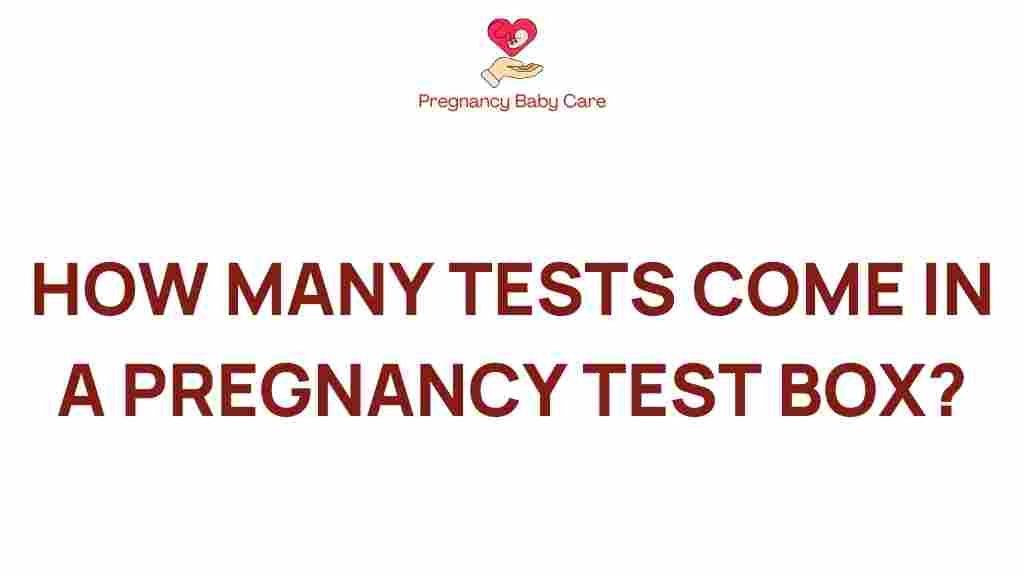Unlocking the Mystery: How Many Tests Are in a Pregnancy Test Box?
When it comes to home pregnancy tests, one of the most common questions is: how many tests are typically included in a pregnancy test box? Understanding the test box contents can help you make informed decisions about family planning and women’s health. In this article, we will explore the different types of pregnancy tests available, the usual number of tests in a box, and the importance of early detection for pregnancy confirmation.
Understanding Home Pregnancy Tests
Home pregnancy tests are designed to detect the presence of the hormone hCG (human chorionic gonadotropin) in urine. This hormone increases after a fertilized egg implants itself in the uterus, making it a reliable indicator of pregnancy.
Home pregnancy tests are widely used for their convenience and ease of use. They can provide results in just a few minutes, allowing individuals to confirm their pregnancy status without the need for a doctor’s visit.
How Many Tests Are Typically in a Pregnancy Test Box?
The number of tests in a pregnancy test box can vary based on the brand and type of test. Here are some common configurations:
- Single Test Packs: Many brands offer individual test kits, ideal for those who want to confirm their pregnancy quickly without purchasing multiple tests.
- Two-Test Packs: This is a popular choice among consumers. Having two tests allows for retesting after a few days, which is useful if the first test is taken too early.
- Multi-Test Packs: Some brands offer packs with three or more tests. These are beneficial for those who may want to test multiple times or for couples actively trying to conceive.
In general, most pregnancy test boxes contain either one or two tests, with some brands offering more for added convenience. The choice largely depends on personal preference and the strategy for fertility and family planning.
Why Multiple Tests Can Be Beneficial
Testing for pregnancy can be a nerve-wracking experience. Here are several reasons why having multiple tests in a test box can be advantageous:
- Early Detection: If you suspect pregnancy but get a negative result, you might want to retest a few days later. This is especially important since testing too early can lead to false negatives.
- Confirmation: If the first test is positive, it’s often recommended to confirm with another test. This can provide peace of mind.
- Different Times of Day: Some women may prefer to test at different times of the day, and having multiple tests allows for this flexibility.
How to Use a Home Pregnancy Test
Using a home pregnancy test is straightforward, but following the instructions carefully ensures accurate results. Here’s a step-by-step guide:
- Read the Instructions: Each brand can have slightly different instructions. Make sure to read the specific guidelines included in your test box.
- Collect Your Sample: Use the first morning urine for the most accurate result, as it contains the highest concentration of hCG.
- Perform the Test: Depending on the type of test, you may dip the test strip into the urine sample or hold it in the urine stream.
- Wait for the Results: Follow the recommended waiting time, usually around 3 to 5 minutes.
- Read the Results: Check the test window for lines or symbols indicating whether you are pregnant or not.
Troubleshooting Common Issues
Sometimes, you may encounter issues while using a home pregnancy test. Here are some troubleshooting tips:
- Negative Result but Still Suspect Pregnancy: If you suspect you are pregnant but received a negative result, wait a few days and retest. Hormone levels increase as the pregnancy progresses.
- Evaporation Lines: Sometimes, a test can develop a faint line after the waiting period due to evaporation. Always read results within the recommended time frame.
- Expired Tests: Check the expiration date on the packaging. Using an expired test can lead to inaccurate results.
- Improper Usage: Ensure you are following the instructions accurately. Incorrect usage can affect the results.
Importance of Early Detection in Pregnancy Confirmation
Early detection of pregnancy is crucial for several reasons:
- Health Monitoring: Knowing early allows you to begin prenatal care, which is essential for the health of both the mother and baby.
- Emotional Readiness: Confirming pregnancy early can help you mentally prepare for the changes ahead.
- Planning for the Future: Early knowledge of pregnancy can impact decisions regarding work, finances, and lifestyle changes.
Conclusion
Understanding how many tests are in a pregnancy test box is just one aspect of navigating the journey of family planning and women’s health. With most boxes containing one or two tests, having additional tests can be beneficial for confirmation and peace of mind. Proper usage and understanding the results can greatly enhance your experience with home pregnancy tests. For more information on pregnancy tests and their usage, check out this comprehensive guide on home pregnancy tests.
Are you considering starting a family or just want to learn more about your reproductive health? Consult with your healthcare provider to discuss any questions or concerns you may have regarding fertility and early detection of pregnancy.
For more tips and information, visit our women’s health resource page and stay informed about your health choices.
This article is in the category Pregnancy and created by PregnancyBabyCare Team
